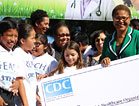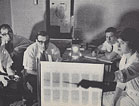Physician Assistants: Collaboration and Care provides classroom resources for educators and students in secondary and higher education. These resources serve as starting points for further exploration into the contributions of physician assistants and the profession, and their role in providing high-quality health care in the United States and around the world. Educators are welcome to adapt these resources in whole or in part as appropriate for their students’ interests and learning goals.
Lesson Plans
Inspiring a Career of Partnership and Service: Physician Assistants
- grade level: 6–8 | subject: health education
Students learn about physician assistants, commonly called PAs, as health care professionals that practice medicine as part of a team. Students become aware that PAs diagnose, treat, and care for patients in collaboration with doctors.
This lesson uses multiple online sources—a video, biographies, and an exhibition—in order to introduce students to what a PA is and what a PA does. As students use several online sources for class activities and assignments, they learn to apply MLA, Chicago, or class-established bibliography formats to cite online sources used in their work. In addition, students conduct guided research, then create display boards about what they have learned about PAs. Students will demonstrate their knowledge through displays and individual essays that describe their understanding of PAs’ roles and contributions in health care.
Physician Assistants: loving what they do!
- grade level: 9–12 | subject: health education
First, students learn what a PA is and how to become one, using online resources, such as the video, “Why I Love Being a PA – PA week” (1:06 mins). Then, students work in small groups, where they research and gather information from websites that inform about the PA profession’s employment outlook, and educational and certification requirements. Students present and share their research findings in a poster session, where they view and learn from all group posters. Afterward, students delve deeper into the PA profession as they explore the impact of PAs and patients being from many backgrounds, represented in Physician Assistants: Collaboration and Care, the Physician Assistant History Society website, and the AAPA’s specialty organizations and PA practice web pages. Finally, students write essays in order to demonstrate what they have learned about PAs and the profession, as well as their understanding of PAs’ roles in health care.
Higher Education
The physician assistant (PA) profession emerged in the 1960s, marking the beginning of what was initially a bold but modest experiment in medical education and health care delivery. Today the profession represents a major innovation in the training of health care professionals and the provision of patient care. The “Reflections” in this module have been developed for helping undergraduate and graduate students appreciate and understand the PA profession as a 20th century social innovation.
Using online primary source materials, biographies, oral histories, and reading assignments, students will explore the origins, professional development, and integration of PAs into all aspects of heath care both nationally and internationally. They will examine the complex social, economic, and political changes that took place in post-World War II America, leading to the creation of this new health profession in the 1960s and 1970s. Students will trace the past and any future changes regarding “who, where, and how” health care is delivered. They will discover how PAs work interdependently with physicians and other health care professionals, both adapting to and brining about social changes in order to meet the people’s ever growing needs for health care. Students will consider PAs as active partners in developing a collaborative health care model that provides accessible, affordable and high-quality health care services in the United States and other countries.
Henry B. Perry, MD, PhD, MPH, authored this module in collaboration with several other health care professionals and educators.
Other Resources
Continue to learn about physician assistants in the past and present, starting with a selected sample of articles and publications listed in the Curator’s Bibliography, and Suggested Readings. Explore how to partner with or become a physician assistant and learn about the work of PAs using online resources that inform about the profession’s history, training and practices, and role in providing high-quality health care.
Continue to OTHER RESOURCES




